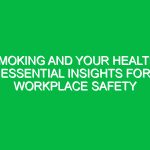Introduction
In today’s world, the importance of wear protective equipment (PPE) cannot be overstated, particularly in the context of Health, Safety, and Environment (HSE) practices. Whether in construction sites, laboratories, or industrial settings, the right PPE serves as a critical line of defense against various workplace Hazards. By understanding and utilizing appropriate protective gear, individuals not only safeguard their well-being but also contribute to a culture of Safety that permeates the entire organization. This essential guide will delve into the various aspects of wear protective equipment, offering insights into its significance, types, best practices, and relevant Regulations.
The Importance of Wear Protective Equipment in HSE
Wear protective equipment plays a pivotal role in mitigating risks associated with workplace environments. The primary goal of PPE is to minimize exposure to Hazards that can cause serious injuries or illnesses. For instance, in a construction setting, workers are exposed to falling objects, Electrical Hazards, and harmful substances. PPE such as hard hats, Safety Goggles, and gloves serves to shield them from these dangers. Moreover, in industries dealing with chemicals, specialized gloves and respirators are indispensable for protecting against toxic exposure.
Types of Wear Protective Equipment
Understanding the various types of wear protective equipment is essential for ensuring that employees are adequately protected. Here are some of the most common categories:
- Head Protection: Hard hats and helmets are vital in preventing head injuries from falling objects or impacts.
- Eye and Face Protection: Safety glasses, goggles, and face shields protect against flying debris, chemical splashes, and radiation.
- Hearing Protection: Earplugs and earmuffs help safeguard hearing in environments with excessive noise.
- Respiratory Protection: Masks and respirators are crucial for filtering harmful particles and gases from the air.
- Hand Protection: Gloves made from various materials offer protection against cuts, burns, and chemical exposure.
- Foot Protection: Safety boots with steel toes and slip-resistant soles ensure foot Safety in hazardous environments.
- Body Protection: Coveralls, aprons, and vests provide a barrier against chemical spills, heat, and sharp objects.
Best Practices for Using Wear Protective Equipment
While the presence of PPE is crucial, it is equally important to ensure that it is used correctly. Here are some Best Practices for utilizing wear protective equipment:
- Proper Fit: Always ensure that PPE fits well. Ill-fitting equipment can be uncomfortable and may not provide adequate protection.
- Regular Inspections: Conduct routine checks on PPE to identify any damages or wear that might compromise its effectiveness.
- Training and Education: Employees should receive comprehensive Training on the correct usage and limitations of their PPE.
- Maintenance: Ensure that PPE is cleaned and maintained according to the manufacturer’s guidelines to prolong its lifespan.
- Storage: Store protective gear in a clean, dry place to prevent damage and contamination.
Potential Hazards and Risks Associated with Improper Use of PPE
While wear protective equipment is designed to protect, improper use can lead to significant risks. For instance, if safety goggles are not worn correctly, they may not provide the intended coverage, leaving eyes vulnerable to injury. Furthermore, relying solely on PPE without addressing the underlying hazards can create a false sense of security. In an industry where chemical exposure is a concern, for example, workers may neglect to implement proper ventilation, assuming their respirators alone will suffice.
Real-life scenarios illustrate the dangers of improper PPE usage. In a case reported by the Occupational Safety and Health Administration (OSHA), a worker suffered severe eye injuries after failing to wear safety goggles while grinding metal. The incident highlighted the critical need for adherence to safety protocols and the proper use of protective equipment.
Regulations and Standards Governing Wear Protective Equipment
Several regulations and standards govern the use of wear protective equipment within the HSE context. Understanding these guidelines is essential for compliance and safety.
- osha Standards: The Occupational Safety and Health Administration (OSHA) mandates that employers provide appropriate PPE to workers and ensure its proper use under 29 CFR 1910.132.
- ANSI Standards: The American National Standards Institute (ANSI) sets specifications for the performance and testing of PPE, ensuring that equipment meets safety benchmarks.
- ISO Standards: The International Organization for Standardization (ISO) provides global standards for PPE, promoting safety and interoperability across different regions.
Compliance with these regulations not only protects workers but also helps organizations avoid legal liabilities and enhance their safety reputation.
Real-Life Applications and Case Studies
To further understand the significance of wear protective equipment, let’s explore a few case studies from various industries.
In the construction industry, a large-scale project in New York City faced scrutiny after a subcontractor failed to enforce PPE usage among its workers. Following an accident where a worker was struck by falling debris, the company faced fines and a damaged reputation. This incident served as a wake-up call, leading to the implementation of stricter PPE protocols, including mandatory hard hats and harnesses for all personnel on site.
In another example, a chemical manufacturing plant in Texas experienced a near-miss incident involving a toxic gas leak. Fortunately, workers were equipped with appropriate respiratory protection and were able to evacuate safely. This incident underscored the value of PPE in preventing potential disasters and saving lives.
Conclusion
The significance of wear protective equipment in maintaining health, safety, and environmental standards cannot be overstated. As demonstrated throughout this guide, effective PPE usage not only protects individuals from a variety of workplace hazards but also fosters a culture of safety within organizations. Adhering to Best Practices, understanding relevant regulations, and learning from real-life applications can enhance the effectiveness of protective gear. Employers and employees alike must prioritize the correct use of PPE to create safer work environments and promote overall well-being. As we continue to navigate complex and hazardous workplaces, let us remember that the right protective gear is a fundamental component of a comprehensive safety strategy.


